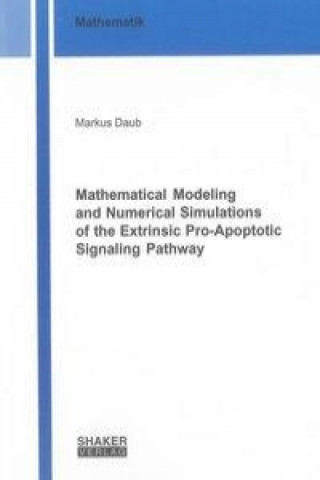
Kód: 12708979
Mathematical Modeling and Numerical Simulations of the Extrinsic Pro-Apoptotic Signaling Pathway
Autor Markus Daub
Apoptosis is a special form of programmed cell death and plays an important role in cancer research for instance. An essential part of the apoptotic process is the extrinsic signaling pathway, which is initiated at the cellular me ... celý popis
- Jazyk:
 Angličtina
Angličtina - Vazba: Brožovaná
- Počet stran: 184
Nakladatelství: Shaker Verlag, 2013
- Více informací o knize

Mohlo by se vám také líbit
-

Dune
249 Kč -

Haunting Adeline
621 Kč -

Berserk Deluxe Volume 2
1092 Kč -

White Nights
71 Kč -

Powerless
268 Kč -

Atomic Habits
330 Kč -

Dune Messiah
228 Kč -

Berserk Deluxe Volume 3
1142 Kč -

One Day
221 Kč -

Berserk Deluxe Volume 1
1115 Kč -

Iron Flame
368 Kč -

Surrounded by Idiots
213 Kč -

Harry Potter and the Prisoner of Azkaban (Minalima Edition)
993 Kč -

Gravity Falls Journal 3
441 Kč -

Heaven Official's Blessing: Tian Guan Ci Fu (Novel) Vol. 1
443 Kč -

The Creative Act
568 Kč -

Dune
276 Kč -

Hunting Adeline
624 Kč -

A Little Life
268 Kč -

Children of Dune
230 Kč -

Heaven Official's Blessing: Tian Guan Ci Fu (Novel) Vol. 2
427 Kč
Informovat o naskladnění knihy
Zadejte do formuláře e-mailovou adresu a jakmile knihu naskladníme, zašleme vám o tom zprávu. Pohlídáme vše za vás.
Více informací o knize Mathematical Modeling and Numerical Simulations of the Extrinsic Pro-Apoptotic Signaling Pathway
 Anotace knihy
Anotace knihy
Apoptosis is a special form of programmed cell death and plays an important role in cancer research for instance. An essential part of the apoptotic process is the extrinsic signaling pathway, which is initiated at the cellular membrane by active ligand-receptor clusters. The activation of special proteins, so-called caspases, starts a caspase cascade, a reaction network of diverse caspase types, that finally results in the death of the cell. The extrinsic signaling pathway can simply be separated into two components: on the one hand, the formation of ligand-receptor clusters on the cellular membrane which act as stimulus of the signaling pathway, and on the other hand, the intracellular reaction network where diverse caspase types are involved in. In this thesis, mathematical models for these two processes are introduced and analyzed. According to the structure of the signaling pathway, the thesis is separated into two parts. 1) In the first part of the thesis, we introduce a spatially extended reaction-diffusion model for the reaction network with diverse caspase types. First, we show that the system has an unstable and two asymptotically stable, spatially homogeneous, stationary solutions. Moreover, we prove that the reaction-diffusion system admits a bounded invariant region that guarantees the boundedness of the solution for all time. After the analytic part of the first chapter, we proceed with a numerical analysis of the reaction-diffusion system. The numerical simulation shows that the diffusion rapidly balances the caspase concentration and that the behavior of the system is subsequently described by the reaction kinetics. We use this fact for the investigation of the long-time behavior of the reaction-diffusion system and split the simulation into two steps. With numerical simulations, we show that the system is switch-like concerning the initial condition with the outputs "cell death" or "cell survival". A typical structure of solutions of bistable reaction-diffusion systems is a traveling wave. Solving the initial value problem numerically presents traveling wave solutions, and we determine their velocity and direction of travel. However, traveling wave solutions only exist on a large spatial scale. 2) In the second part of the thesis, we introduce a particle model for the motion of the receptors and ligands on the cell membrane in order to investigate the formation of ligandreceptor clusters. The motion of the particles is random and modeled as a Brownian motion. Additionally, we take into account the interaction between the ligands and receptors and derive stochastic differential equations for the translation and rotation of the particles. Since we consider a huge amount of receptors and ligands, we obtain a high-dimensional system of stochastic differential equations which are nonlinearly coupled by the mutual interaction of the particles. The flexible form of the particle model enables the comparison of different biological hypotheses concerning the binding behavior of the receptors. Due to the high complexity of the simulation, the algorithms implemented in the computer language C are mapped to GPGPU architectures in order to parallelize the computation of the interactions. This enables us to perform simulations for various particle configurations and compare the results concerning the formation of signal competent cluster units. In order to analyze large ligand-receptor clusters and especially their structure, we apply the visualization-tool cellVis.
 Parametry knihy
Parametry knihy
- Plný název: Mathematical Modeling and Numerical Simulations of the Extrinsic Pro-Apoptotic Signaling Pathway
- Autor: Markus Daub
- Jazyk:
 Angličtina
Angličtina - Vazba: Brožovaná
- Počet stran: 184
- EAN: 9783844017281
- ISBN: 3844017283
- ID: 12708979
- Nakladatelství: Shaker Verlag
- Hmotnost: 258 g
- Rozměry: 211 × 152 × 17 mm
- Datum vydání: March 2013
Osobní odběr Praha, Brno a 12903 dalších
Copyright ©2008-24 nejlevnejsi-knihy.cz Všechna práva vyhrazenaSoukromíCookies



 Vrácení do měsíce
Vrácení do měsíce 571 999 099 (8-15.30h)
571 999 099 (8-15.30h)